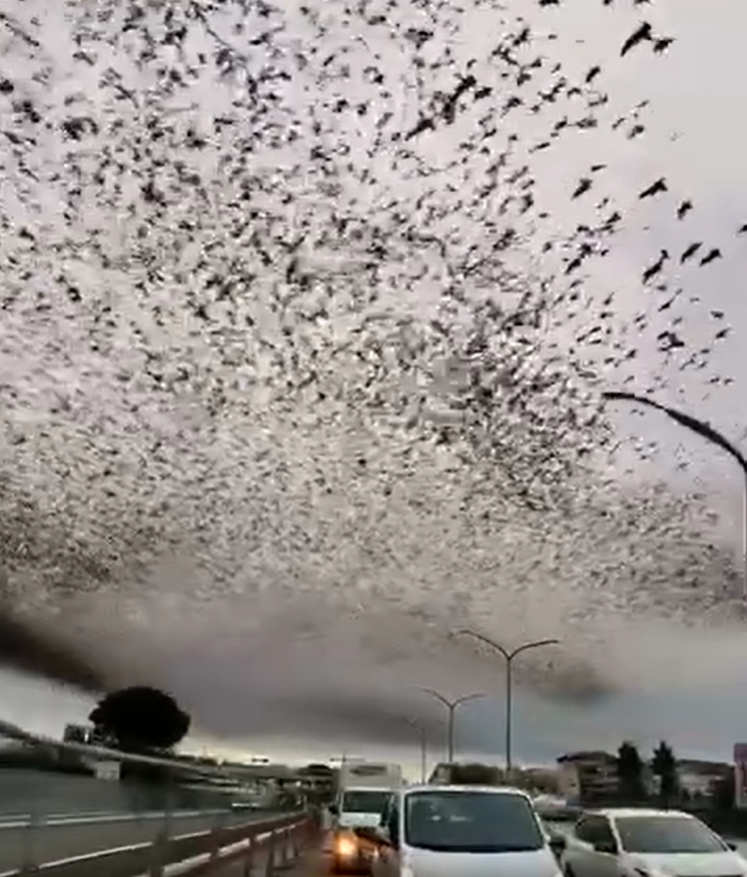When Birds Darken the Skies: The Stunning Starling Spectacle Over Rome
Every winter, as the sun begins its descent over the ancient city of Rome, something extraordinary happens. The skies, painted in hues of gold and crimson, suddenly shift as thousands upon thousands of starlings take flight. Moving as one, the flocks swirl and dip, creating a living canvas that astonishes both locals and visitors alike. To those who witness it for the first time, it can feel as if the heavens themselves are alive, darkened by a wave of wings that stretches as far as the eye can see.
The Annual Arrival of the Starlings
This breathtaking phenomenon begins each year with the arrival of winter. Fleeing the icy winds and scarce food of northern Europe, countless starlings migrate southward, seeking the milder climate of Italy. For centuries, Rome has been a sanctuary for these remarkable birds, offering warmth, shelter, and an abundance of resources.
As the days grow shorter, their presence becomes impossible to ignore. Tourists visiting iconic landmarks such as the Colosseum, the Vatican, or the Tiber River often look up in wonder as the skies suddenly ripple with dark, shifting clouds. Residents, long accustomed to the spectacle, still pause to admire the dazzling choreography that repeats itself year after year.
A Dance in the Sky
Perhaps the most mesmerizing aspect of the starlings’ visit is their sunset performance, known as a murmuration. Thousands of birds, sometimes tens of thousands, fly in perfect harmony, twisting and folding through the air with astonishing precision.
No leader guides them, yet each bird instinctively mirrors the movements of those around it. Scientists believe the flock’s motion is a complex communication system, a survival mechanism designed to protect against predators such as falcons. The result, however, is nothing short of a natural ballet — fluid, ever‑changing, and utterly spellbinding.
From below, the patterns look like waves rolling across the sky, or brushstrokes from an invisible artist painting fleeting masterpieces in the evening light. It is a performance that no human choreographer could ever replicate, a reminder of the elegance hidden within the natural world.
Awe and Inconvenience
Yet for all its beauty, the spectacle is not without problems. When the birds settle for the night in Rome’s trees, they leave behind a less enchanting legacy. Streets, cars, and squares are often covered with droppings, turning cobblestones slippery and creating extra work for city crews. For residents, the arrival of the starlings is as much a nuisance as it is a wonder.
Local authorities have tried numerous methods to deter the birds, from blasting loud noises to flashing strobe lights. But the starlings, accustomed to the bustle of urban life, remain undeterred. Year after year, they return, undaunted by human efforts to push them away.
“It’s a love‑hate relationship,” one Roman shop owner explained. “They make a mess, but the sight of them flying over the city is unforgettable.”
Scientists Seek Answers
Researchers from across Europe have studied the phenomenon, eager to understand how such massive groups of birds can coordinate with such flawless precision. Using high‑speed cameras and computer simulations, they’ve discovered that each starling reacts almost instantly to the movement of its nearest neighbors, creating a chain reaction that ripples through the entire flock in fractions of a second.
The behavior serves not only to confuse predators but also to strengthen the unity of the group, ensuring the survival of as many birds as possible. For scientists, murmurations represent one of the most fascinating examples of collective intelligence in the animal kingdom.
A Gift to the City of Eternal Beauty
Despite the complaints, many Romans and visitors view the starlings as a kind of seasonal gift — a moment of wild magic that contrasts with the city’s ancient stones and bustling traffic. Watching the birds swirl above the Colosseum or glide over the Tiber at dusk creates a powerful connection between nature and history, a reminder that Rome is not only a monument to human achievement but also a sanctuary for life.
Tourists often describe the experience as otherworldly. “It’s like standing under a moving sky,” one visitor shared. “For a few minutes, you forget everything else and just watch.”
A Poetic Display of Survival
Ultimately, the winter invasion of starlings is more than just a visual wonder. It is a story of survival, resilience, and unity. These birds, driven by instinct and guided by nature’s rhythm, remind us that even in the heart of a city filled with history, the wild continues to write its own timeless story.
For Rome, the arrival of the starlings is both a challenge and a blessing. They may darken the skies and leave their mark on the streets, but they also leave behind something far more valuable: a fleeting reminder of nature’s unmatched beauty and the power of life when it moves in harmony.




